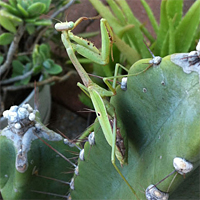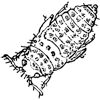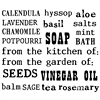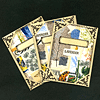
|
|
 |
|
Beneficial Insects in the Gardenby Carolyn HasenfratzDo you like this material? Share it! Are you interested in making your garden more habitable to beneficial insects? Here is a list of invertebrates you might want in your garden, followed by a chart showing what plants are likely to attract them and what plants may repel pests. Beneficial Insects and Invertebrates:
Butterflies: Most people want them in the garden for their beauty. Some butterfly species also contribute to pollinating. The larvae of some species can be pests on certain crops so you may or may not consider these beneficial depending on what you are trying to accomplish. Some species eat wooly aphids. Dragonflies: They eat mosquitoes, aphids, gnats, flies, swarming ants, swarming termites, midges and other pests. Dragonflies are attracted to ponds and marshy areas - the larvae live in water, and predate on mosquito larvae. Earthworms: They turn organic matter into fertilizer and make holes in the soil for drainage and plant roots. Put organic matter in or on the soil to attract a population. Ground Beetles: Mulch, perennial plants, rocks and logs will attract ground beetles. They eat slugs, snails, cutworms, root maggots and Colorado potato beetle larvae. Some will eat caterpillars and insect eggs. Hover Flies: Also known as Syrphid flies. They look like a small bee and feed on aphids, spider mites, mealy bugs, scale insects, green flies and small caterpillars. They are active early in spring. They also help to pollinate. Lacewing Bugs: Larvae feed on aphids, thrips, scales, moth eggs, small caterpillars and mites. Ladybugs: The adults and larvae consume aphids, spider mites and other soft-bodied pests.
Pill Bugs: Some people consider these to be pests and not beneficial. They have been one of my favorite bugs since I was very small and I've always paid attention to where I see them. I recall only ever seeing them around moist rotting wood or cardboard or dead plant matter, not on live plants, so to me they are beneficial because they help turn wood and other dead plant products into fertilizer. I have addded some to my vermiculture bin where they help break down the shredded paper bedding that I add from time to time. They are terrestrial crustaceans, not insects. They breathe with gills and that's why they stay in moist areas. Some people report that they are destructive to young plants. Predatory Bugs: This group includes pirate bugs, ambush bugs, assassin bugs, and wheel bugs (a favorite of mine!) Members of this group eat tomato hornworms, thrips, spider mites, insect eggs, leafhopper nymphs, aphids, corn earworms and other small caterpillars. Don't pick up members of the true bug family - many will bite!
Predatory wasps: Depending on the species will eat many garden pests and eggs including moths, caterpillars, beetle larvae, aphids and flies. They also do some pollination. Predatory Flies: Includes robber flies and tachinid flies. They eat cutworms, armyworms, tent caterpillars, cabbage loopers, gypsy moths, sawflies, Japanese beetles, corn borers, stink bugs, squash bugs and sow bugs. They are attracted by pollen and nectar. Soldier Beetles: They eat aphids, caterpillars, corn rootworms, cucumber beetles and grasshopper eggs. Spiders: If you want to increase the spider population in your garden, you can provide shelter in the form of permanent perennial plantings and straw mulch. Spiders can be a lot less scary if you identify what kind are in your garden and read about them. Beneficial Plant Chart*
*Sources - besides various internet sources, I used: Rodale's Encyclopedia of Herbs Other Resources
Do you have comments or questions? Please email me. Return to top |
Newsletter
Would you like to sign up for my e-newsletter, Carolyn's Creative Connections? It's about how to enhance your life as a crafter, artist, designer, business person, hobbyist or anyone who values creativity. Exclusively for subscribers - at least one free printable download in every issue! Products from Carolyn's Stamp Store:
|
|
|
|
|
| ||
|
| ||
|
Carolyn's Stamp Store Rubber art stamps designed by Carolyn Hasenfratz for your creative craft projects. Many Route 66 and faux postage designs available. www.carolynsstampstore.com |
Carolyn Hasenfratz Design Award-winning web design and development, Flash animation, presentations and slide shows, and graphic design. www.chasenfratz.com |
The John's Modern Cabins News Chronicles historic preservation efforts on Route 66, the Main Street of America. www.jmcnews.com |
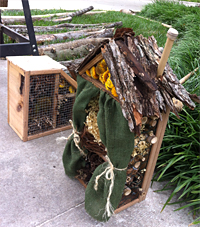 Bees: Important pollinators that are attracted by all flowering plants. Try to provide plants that bloom at different times. Fancy hybrids may look nice but be lacking as a food source - try to include some natives and heirloom varieties. The flowers don't necessarily have to be big - in my garden small flowers such as basil and mints are very popular with the bees and other desireable insects.
Bees: Important pollinators that are attracted by all flowering plants. Try to provide plants that bloom at different times. Fancy hybrids may look nice but be lacking as a food source - try to include some natives and heirloom varieties. The flowers don't necessarily have to be big - in my garden small flowers such as basil and mints are very popular with the bees and other desireable insects.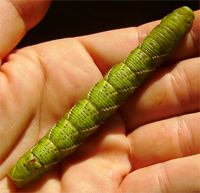 Moths: Some species are important pollinators while others can be pests. The example at left, a tobacco hornworm, is a pest on plants such as tomatoes, tobacco, potatoes and peppers. They may become prey to parasitic wasps. If you observe a larva with white cocoons on it, it has been parasitized and should be left in the garden to conserve the parasitic wasps that will emerge. Hand-picking is a good control otherwise. The adults are Carolina Sphinx Moths, and they are attracted by Japanese honeysuckle, moonflower and petunias, so you might want to avoid planting those if you have a hornworm problem.
Moths: Some species are important pollinators while others can be pests. The example at left, a tobacco hornworm, is a pest on plants such as tomatoes, tobacco, potatoes and peppers. They may become prey to parasitic wasps. If you observe a larva with white cocoons on it, it has been parasitized and should be left in the garden to conserve the parasitic wasps that will emerge. Hand-picking is a good control otherwise. The adults are Carolina Sphinx Moths, and they are attracted by Japanese honeysuckle, moonflower and petunias, so you might want to avoid planting those if you have a hornworm problem.
